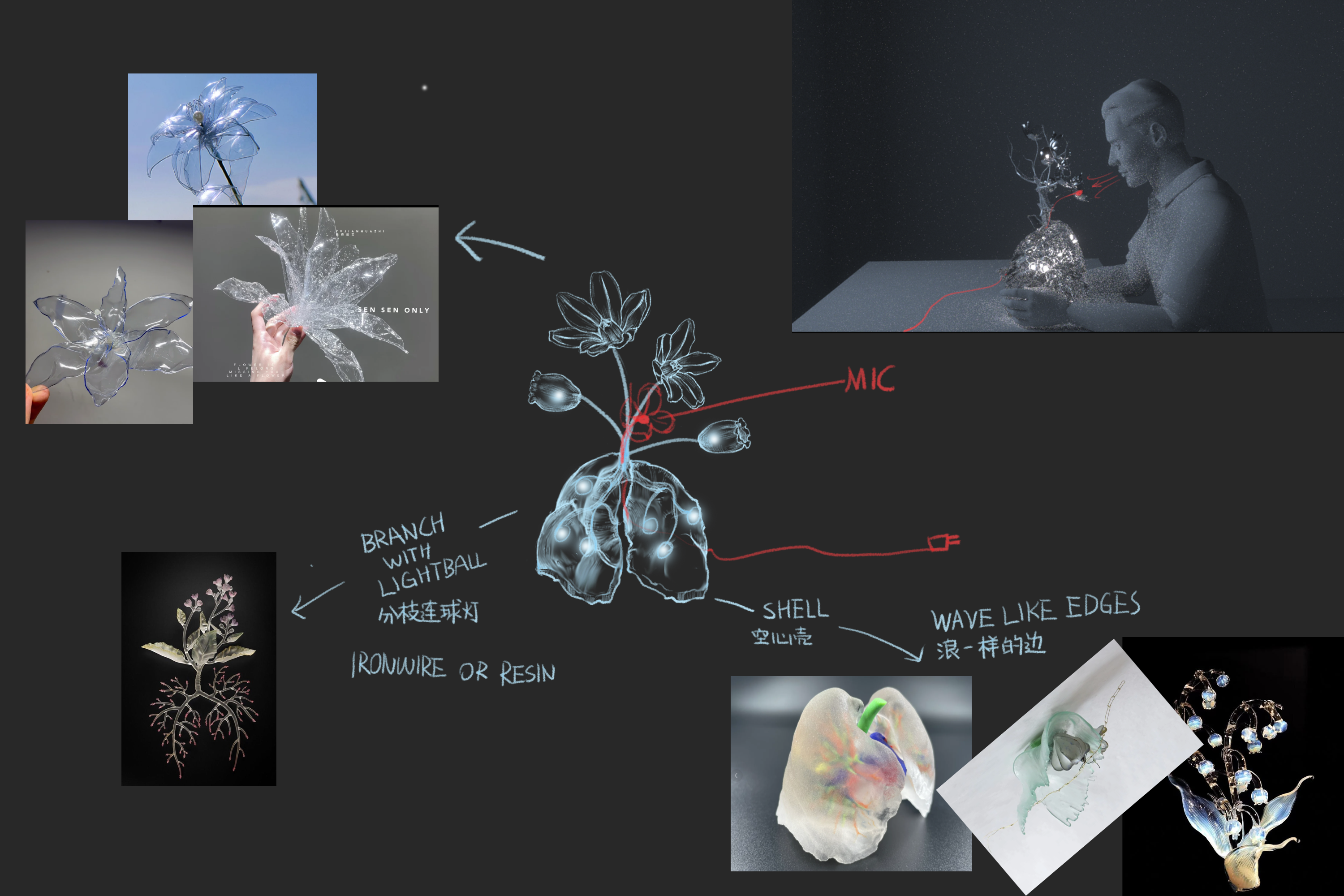Author: Xinyi Qian
Reflections & Future Improvements
Throughout the exhibition, both our own observations and audience feedback revealed several areas for improvement — offering valuable guidance for future iterations of the project.
1. Interaction Design
-
The microphone required users to blow air at a very specific angle and intensity in order to trigger the visuals. This made the interaction feel unintuitive or difficult for some.
-
Low sensitivity and limited number of microphones reduced accessibility and responsiveness.
-
Some participants suggested considering other ways of sensing breath — such as body movement, pulse, or temperature — by using more diverse sensors.
-
The 5-second inhale duration was considered too long by several users. A 4:6 breathing rhythm (inhale for 4 seconds, exhale for 6) was proposed as a more natural and meditative alternative.
2. Sound Design
-
The sound of blowing air was described as storm-like and slightly harsh. Visitors recommended exploring softer or more ambient alternatives to avoid overwhelming the calm atmosphere.
-
Suggestions were made to add layered audio effects to enrich the sonic environment.
-
Adding surround sound or echo effects through multiple speakers was also proposed, to create a more immersive spatial experience.
3. Visuals
-
-
Visual richness: The visual changes were not dynamic enough and became repetitive over time. They suggested adding more variation, layering, or complexity to keep the experience engaging throughout.
-
Visual consistency: Some feedback pointed out a lack of coherence between the physical installation and the digital visuals. Jules suggested importing photographs of our sculpture into TouchDesigner and transforming them into abstract visuals. This could help bridge the gap between physical and digital elements, creating a more unified visual language — similar to the method used in 77 Million Paintings.
-
Presentation Record
Time & Dates | 8:30AM-12:30PM, April 4, 2025
Members | Process Group & Philly
Location | Alison House Atrium
8:30am
On the day of our exhibition, we arrived at the venue at 8:30am to begin setting up. We borrowed some cushions and low tables from Alison House and arranged the space according to our pre-designed layout. To make the area more inviting and comfortable, we added two extra cushions and set up additional screens for visitors to relax and enjoy the work.
Our installation was carefully placed in position, accompanied by the handmade flower sculpture, glowing orb lights, and LED strips to enhance the atmosphere. Ashley brought her projector light, which helped create a warm, immersive vibe. Meanwhile, other team members prepared printed materials, including postcards, flyers, and a step-by-step interaction guide, which we displayed at the entrance.
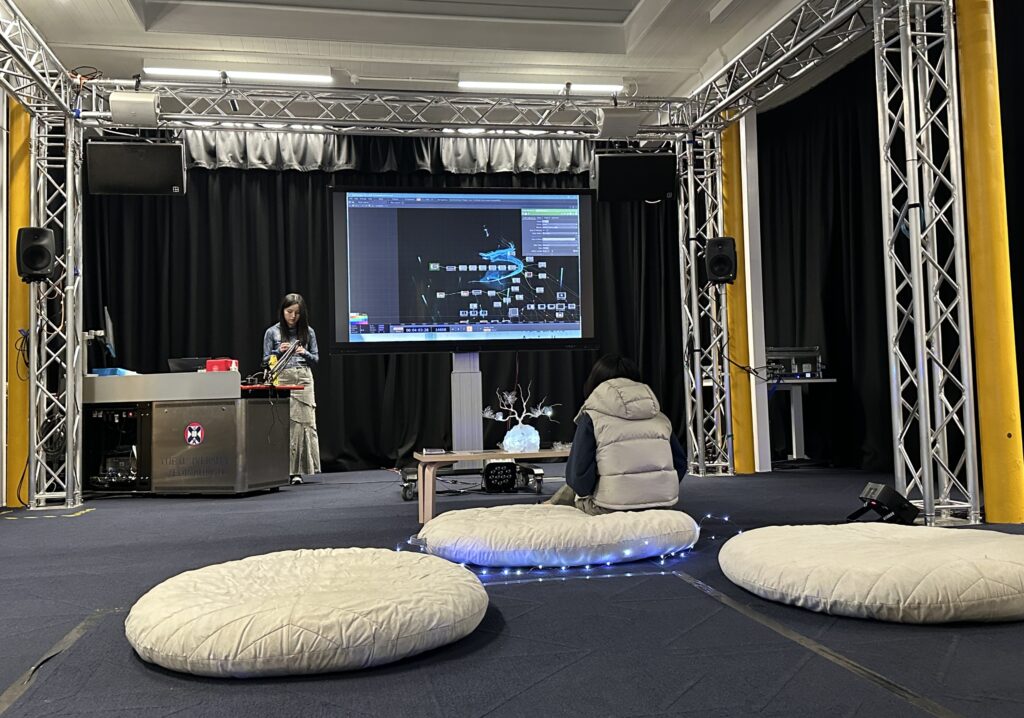
9:00am
At 9:00am, Philly arrived with microphones and lighting equipment. With his help, we started the technical setup and testing. There were some initial issues with audio connections and device compatibility, but Philly was quick to assist and troubleshoot. We then followed our planned schedule: testing audio and visual responsiveness.
During this process, we encountered a few problems — the microphone sensitivity was too low, which affected both the sound and the visuals in TouchDesigner. Ashley and Philly worked together to adjust the audio settings, while Hefan carefully fine-tuned the visuals to match our original intention.
10:30am
At the same time, Yixuan was documenting the whole process, taking behind-the-scenes footage and detail shots of the space and installation. Around 10:30am, a small group of meditation enthusiasts arrived for testing. We guided them through the experience and conducted some short interviews to collect feedback.
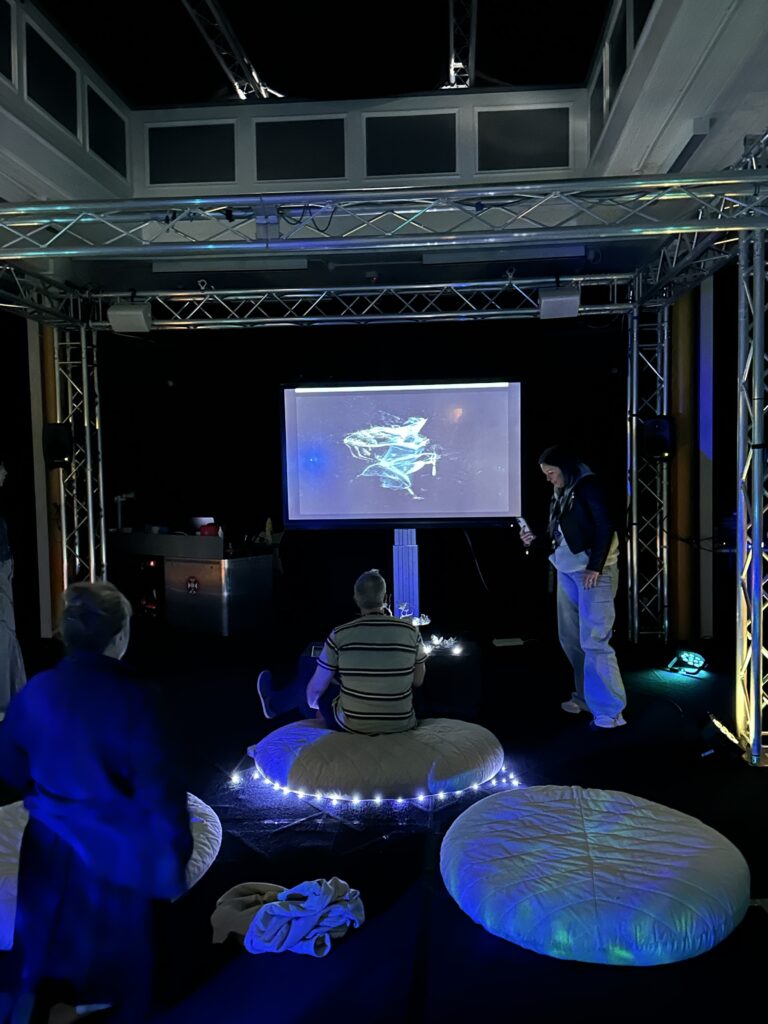
11:00am
By 11:00am, more and more visitors began to enter the space. Jules arrived as well, and he spent some time engaging deeply with our installation. He gave us valuable feedback — including actionable suggestions like improving the surround sound. Ashley and Philly began working on that right away.
11:30am
At 11:30am, the exhibition officially started. Everything ran smoothly, and many visitors interacted with the installation just as we had hoped. However, we also noticed a few unexpected issues and took the chance to interview some willing participants. The event wrapped up around 1:00pm.

2nd Intergration & Trouble Shooting
Overview: Successfully connected TouchDesigner and Max, and optimized visual parameters in TouchDesigner.
Dates of Development | March 26, 2025
Process Group | Xinyi Qian, Ashley Loera,Hefan Zhang
Part 1:
Ashley and I went to Alison House this afternoon to meet with Philly. While Ashley consulted Philly about audio processing issues in Max, I prepared for the connection test. After resolving her problem, we successfully connected Max and TD.
However, when I later returned to test the setup with the DPA microphone, I encountered a new issue: the airflow was too concentrated, resulting in a harsh, noisy sound. Ashley is currently working on refining this by adjusting the audio input processing to reduce the rough airflow noise.
Part 2:
In parallel, Hefan optimized the visuals in TD based on feedback from Philly and Jules, adding richer and more detailed effects. I conducted breathing tests with the new visuals and collaborated with Hefan to debug and refine the following aspects:
-
Math Mapping: We adjusted the mapping so that the airflow data captured by the microphone results in smoother and more continuous visual transitions.



-
Color Saturation & Noise: The previous version of the visuals was overly saturated. We adjusted the Levels and Noise parameters to create a more subtle, natural effect.
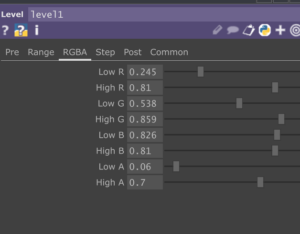
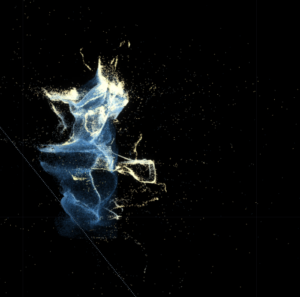
1st Intergration & Trouble Shooting
Overview: Integrate the existing visuals and audio to review the effect, and troubleshoot any unresolved issues
Dates of Development | March 15, 2025
Process Group | Touch Designer & Max

-
This integration began by incorporating the cyclic breathing-inspired visuals created by Yixuan into Hefan’s breathing-responsive visuals. The combined visuals served as a background to guide the breathing rhythm. We also tested how well it aligned with Roulin’s background music.
Issues Identified:
- The breathing-responsive visuals felt somewhat monotonous, as they only involved scaling.
- The cyclic background visuals lacked variation.
-
I brought the borrowed DPA microphone and RME audio interface, and the team conducted a breathing test to observe how airflow influenced the visual changes. We found that the visuals were highly unstable, sometimes fluctuating excessively. Yixuan adjusted the range settings, making the visual transitions smoother.
Meanwhile, Ashley brought a router to attempt transferring TD data from my computer to her Max setup. Yixuan and Ashley worked on resolving the connection. They were successfully able to connect the Router to my computer which allowed Ashley’s to receive data directly from TD from my computer.
-
On the other side, we discussed Li’s installation design. We explored two potential plans:
- Plan 1: Creating a non-contact breathing mask with a hidden microphone. This design would better capture the exhaled airflow and create a recirculation effect.
- Plan 2: Designing a potted plant installation, where the microphone would be embedded as a branch of the plant.
The final decision is still pending.
Continue reading “1st Intergration & Trouble Shooting”
Touchdesigner breath detection testing
Overview: This test is based on Hefan’s TD testing, focusing on refining the interaction between breath detection and visual output. The goal was to optimize microphone placement, enhance the sensitivity of airflow detection, and improve the overall experience of guided breathing. Key areas of experimentation included adjusting audio analysis parameters, refining the response to different breathing intensities, and ensuring smooth visual transitions.
Findings & Adjustments
Breath Sensitivity & Microphone Positioning
- Issue: When blowing gently, the system did not detect sufficient airflow, resulting in weak visual feedback.
- Solution: The microphone was found to be most sensitive when placed horizontally, 3-4 cm below the mouth. This position maximized airflow detection while minimizing background noise.
- Next Steps: Implement a fixed microphone stand or position guide to ensure all participants use the optimal placement without manual adjustments.

Breath Decay & Visual Transition
- Issue: During guided breathing (5s inhale, 5s exhale), the airflow naturally decreases over time. This caused a sudden drop in visual output, making the transition feel abrupt.
- Solution: Adjust audio smoothing settings and refine the visual decay curve to create a more natural fade-out effect as breath weakens.
- Next Steps: Experiment with lag filters and dynamic scaling to create a gradual transition when airflow weakens.


High-Frequency Sensitivity & Detection Consistency
- Observation: The system responded to breath but not to spoken words, confirming that it effectively isolates airflow instead of voice.
- Adjustment: The high-frequency range was the most responsive, while the low-frequency range was unnecessary for detecting breath.
- Next Steps: Fine-tune gain and threshold settings to ensure consistent response across different breath intensities.
Next Steps & Refinements
- Implement a fixed microphone position to avoid user adjustments.(Maybe put it within Installation)
- Optimize audio analysis parameters to ensure smooth transitions when breath intensity decreases.
- Conduct further tests to validate sensitivity across different users and refine visual-matching dynamics.
Interview Outline & Analysis (along with Ethics Form & Interview Consents)
Overview: Our group conducted a series of interviews to explore how people perceive breathing and its connection to emotions, physical state, visuals, and sound, supporting ourproject.
Interview Goals
- Understand when people become aware of their breathing.
- Explore how different breathing states (deep vs. rapid) affect emotions and the body.
- Gather insights on visual and auditory representations of breathing for interactive design.
Interview Participants
Participants included but were not limited to:
- Meditation practitioners : Highly aware of breathing patterns.
- Medical students : Providing a physiological perspective.
- General participants : Offering everyday experiences.
The interview findings provide diverse user perspectives for our interactive design.
Interview Analysis
This interview focused on three core aspects: perception of breathing, emotional & physiological experiences, and audio-visual associations. The interview consisted of nine questions.
Interview Analysis English Version
Ethics Form & Interview Cosnents
6th Meeting 28-02-2025
Overview: Today’s meeting is divided into three parts. First, we go over the project logic once again. Then, we check in on individual progress. Finally, we attempt to connect TD with Max.
During our reassessment of the project framework, Can pointed out that our work lacks sufficient research to support the creative process. To address this issue, we plan to conduct primary research through interviews to gather relevant insights. Specifically, we intend to interview meditation practitioners, members of yoga communities, and the general public to extract key themes from their responses. These themes will serve as the foundation for creative exploration, providing a conceptual basis for our sound and visual design. This approach will ensure that our work is both theoretically grounded and conceptually cohesive.
Next, we shared our respective progress. Xinyi shared the installation plan, , Roulin shared the loop audio she created for the project, and Hefan showed her experiment in Touch Designer.
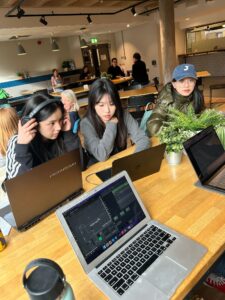
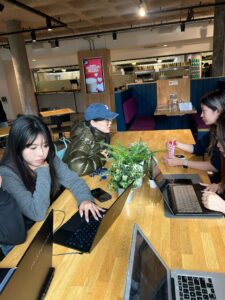
Ashley and Hefan are attempting TD Max connection, while Can, Yixuan, and Li are testing the connection between Arduino and TD
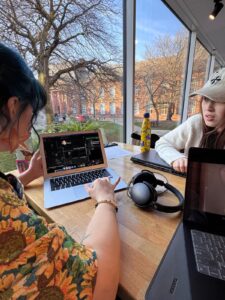
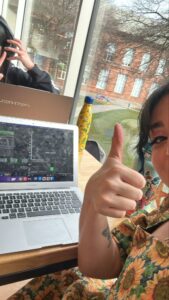
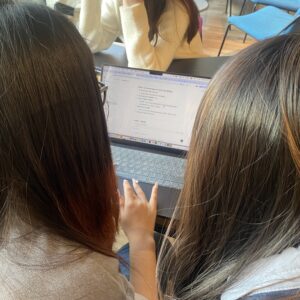
This is the manpower requirement for installation manufacturing
-
- Design Sketches
- Sensor Cotainer
- Lung Model
- Plastic Flower Model
- Lighting & Space Setup
- Other……
We have decided to gather in the common room downstairs from Yixuan’s dormitory to make it together after the materials are ready in the later stage, and Roulin mentioned that she has learned how to light up. In addition, Ashley mentioned that how to place the computers on the exhibition space is also a question that needs to be considered.
Layout & Installation Design (Updated)
Updated post 18 April 2025
Based on the previous installation design and layout, I refined the structural details and created a new spatial simulation tailored to the exhibition venue.

Continue reading “Layout & Installation Design (Updated)”
Material Requirements List
This is our installation material requirements list, including categories, descriptions, and prices. We have also embedded links.
We are planning to purchase materials for our installation online, such as resin, a heat gun, and other supplies. I would like to confirm whether it is necessary to request a receipt for each purchase, or if an online order confirmation would be sufficient.
For the lung component, we plan to use a hand-moldable resin that doesn’t require a mold, as molds are quite expensive. This resin can be shaped by hand and is also reusable. The cost is £6.5 per 100g, and based on ChatGPT’s calculation, we will need around 600g to create a lung-sized shell. So, we are tentatively planning to purchase six units. I’m not sure if we’ll need pigments, but I found some glitter options that we could consider if necessary.
For the plastic flowers, we will repurpose plastic bottles, which won’t require additional costs. However, we will need to purchase some tools to process them.
For lighting, I’ve looked into decorative light spheres and LED strips, which are quite affordable. The venue’s general lighting equipment can be borrowed via Book It.
